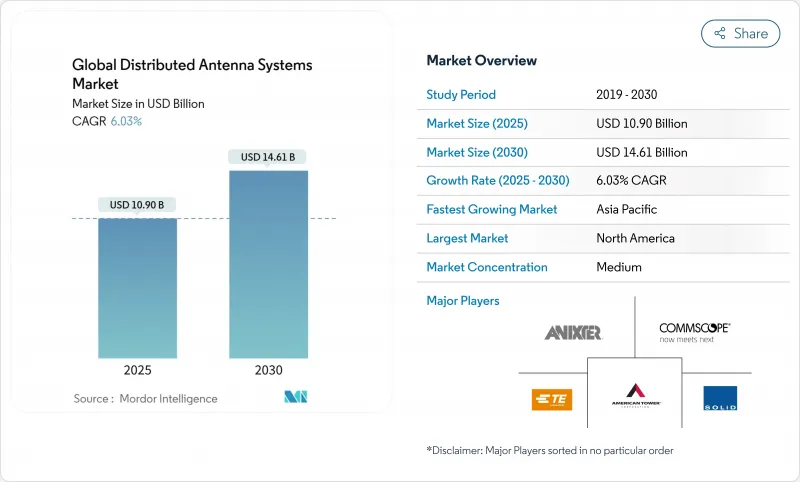
|
市場調査レポート
商品コード
1850282
世界の分散アンテナシステム:市場シェア分析、産業動向、統計、成長予測(2025年~2030年)Global Distributed Antenna Systems - Market Share Analysis, Industry Trends & Statistics, Growth Forecasts (2025 - 2030) |
||||||
カスタマイズ可能
適宜更新あり
|
|||||||
| 世界の分散アンテナシステム:市場シェア分析、産業動向、統計、成長予測(2025年~2030年) |
|
出版日: 2025年06月19日
発行: Mordor Intelligence
ページ情報: 英文 120 Pages
納期: 2~3営業日
|
概要
世界の分散アンテナシステム市場規模は2025年に109億米ドル、2030年には146億1,000万米ドルに達すると推定・予測、予測期間(2025-2030年)のCAGRは6.03%。

分散アンテナシステム市場規模は、2025年に109億米ドル、2030年には146億1,000万米ドルに達すると予測され、予測期間中のCAGRは6.03%です。5Gの高密度化によって屋内のカバレッジギャップが露呈する一方で、ニュートラルホストのビジネスモデルによって会場オーナーの資本負担が軽減されるため、需要は加速しています。パッシブ・アーキテクチャーは引き続きコスト重視の配備を支配しており、公共安全無線のカバレッジに関する規制の義務化によって、景気変動時にも支出サイクルは回復力を維持しています。人工知能ベースの自己最適化ネットワークは運用コストを削減し始めており、デジタルDAS設計はエネルギー消費を抑え、企業の持続可能性目標の高まりに沿った展開となっています。
世界の分散アンテナシステム市場動向と洞察
5Gネットワークの高密度化が屋内カバー需要を押し上げる
モバイルデータの利用パターンでは、トラフィックの80%以上が屋内で発生することが確認されているが、大容量の5Gセルを駆動する同じミッドバンドおよびミリ波の信号は、建物内で急速に減衰します。ベライゾンのような通信事業者は、サービス品質を維持するために、固定無線サービスとミリ波DASの展開を組み合わせています。会場のオーナーは現在、不動産の評価と屋内接続の保証を結びつけており、コストに敏感な商業用不動産分野でも投資判断を迫られています。
ビル内公共安全カバレッジに対する規制の義務化
国際消防法をモデルにした建築基準では、施設全体で95%、階段の吹き抜けなどの重要なゾーンでは99%の信号カバレッジが義務付けられており、公共安全DASに対する非裁量的な需要が生まれています。全米防火協会(National Fire Protection Association)の規則に基づく年次再認証は、収益源に定期的なサービス層を追加します。公共安全DASは、病院や交通機関のハブにも義務付けられるようになり、オプションのアメニティではなく、基本的な建物のインフラになりつつあります。
マルチオペレーターの調整とスペクトラムクリアランスの複雑さ
4つ以上のモバイルネットワーク事業者を満足させなければならない配備は、設計、信号源、周波数クリアランスについて関係者が調整する間、6~12ヶ月間停滞する可能性があります。デジタルDASプラットフォームは、ソフトウェア定義の柔軟性を提供することで、この負担を軽減しますが、エンドツーエンドのソリューションを仲介するニュートラルホストインテグレーターは、不動産所有者に代わって複雑さを吸収することで、頻繁にロールアウトを迅速化します。
セグメント分析
2024年の分散型アンテナシステム市場シェアは、パッシブ・アーキテクチャーが63%を占め、設置コストの低さとメンテナンスの簡便さを優先する中規模会場のオーナーにアピールしています。これらのシステムは、同軸ケーブルやスプリッターを介してRFをルーティングするため、大掛かりなアクティブ・エレクトロニクスが不要となり、その結果、必要な電力が削減されます。ファイバー・バックホールとパッシブ・ディストリビューションを組み合わせたハイブリッドDASは、ホスピタリティ施設やアカデミック・キャンパスで性能と予算制約のバランスを取るため、CAGR 9.06%で成長すると予測されます。アクティブDASは、包括的なカバレッジと大容量がコスト懸念を上回る大規模なスタジアムや空港でその役割を維持する一方、デジタルDASは、将来的にマルチオペレーターをサポートするソフトウェア定義の柔軟性で支持を集めています。
収束しつつある技術ロードマップは、カテゴリー間の歴史的な境界を曖昧にしています。コーニングのEveron 5G Enterprise Radio Access Networkは、スモールセル無線とDASヘッドエンドを統合し、従来のシステムと比較して設置時間を75%、所有コストを50%削減します。ベンダーは、省エネとモジュラースケーラビリティを強調するようになっており、次世代プラットフォームは、購入者を固定されたトポロジに固定することなく、性能と持続可能性の両方の要件を満たすものと位置づけられています。
地域分析
2024年の分散型アンテナシステム市場シェアは北米が39%で首位に立ちました。国際消防法(International Fire Code)や全米防火協会(National Fire Protection Association)の規格に組み込まれた要件は、マクロ経済のサイクルに関係なく強制的な需要を生み出します。米国の通信事業者は、マクロの高密度化を補完するためにミリ波のスモールセルとDASに大きく傾注しており、不動産所有者は、カバレッジを向上させながら初期費用を抑えられるニュートラルホストプラットフォームをますます好むようになっています。
欧州では、建築基準法の改正や持続可能性目標に対応するため、古いオフィスビルの改修が進んでおり、着実な更新需要が見られます。英国とドイツでは、複数事業者による交渉が複雑化した初期の事例があり、導入スケジュールが長期化することが多いが、承認を合理化できるインテグレーターにとっては肥沃な土壌となっています。一方、フランスとスペインでは、政府が後押しするブロードバンド政策により、デジタルインフラに補助金が振り向けられ、交通の要所やヘルスケアキャンパスで官民DASパートナーシップの道が切り開かれています。
アジア太平洋地域は、2030年までのCAGRが9.37%で最も急成長している地域であり、中国の進行中の都市化、日本の高密度交通システム、インドの高級商業不動産へのキャッチアップ投資が後押ししています。中国の配備は、DASとIoTセンサーのバックボーンを融合させるスマートシティプロジェクトと一致しており、日本の事業者は、大規模なスポーツイベントを前に、地下鉄駅や複合商業施設でのシームレスな接続を優先しています。日本のローカル5GやインドのプライベートLTEライセンスのようなスペクトル共有メカニズムは、地域全体でコスト最適化された屋内カバレッジモデルへの広範なシフトを反映し、中立的なホスト実験のための規制上の滑走路を提供します。
その他の特典:
- エクセル形式の市場予測(ME)シート
- 3ヶ月間のアナリストサポート
よくあるご質問
目次
第1章 イントロダクション
- 調査の前提条件と市場の定義
- 調査範囲
第2章 調査手法
第3章 エグゼクティブサマリー
第4章 市場情勢
- 市場概要
- 市場促進要因
- 5Gネットワークの高密度化により屋内カバレッジの需要が増加
- 建物内の公共安全に関する規制義務
- 中立ホストビジネスモデルが不動産所有者の設備投資を削減
- AI駆動型DAS自己最適化によりネットワークOPEXを削減
- 市場抑制要因
- 複数事業者の調整とスペクトルクリアランスの複雑さ
- エネルギー集約型システムへの持続可能性の圧力
- バリュー/サプライチェーン分析
- 規制情勢
- テクノロジーの展望
- ポーターのファイブフォース分析
- 供給企業の交渉力
- 買い手の交渉力
- 新規参入業者の脅威
- 代替品の脅威
- 競争企業間の敵対関係
第5章 市場規模と成長予測
- タイプ別
- アクティブ
- パッシブ
- デジタル
- ハイブリッド
- エンドユーザー別
- 製造業
- ヘルスケア
- 政府と公共の安全
- 運輸・物流
- スポーツとエンターテイメント会場
- 通信事業者
- その他の商業部門
- 用途別
- エンタープライズDAS
- 公共安全DAS
- ニュートラルホスト/マルチオペレータDAS
- 地域別
- 北米
- 米国
- カナダ
- メキシコ
- 南米
- ブラジル
- アルゼンチン
- その他南米
- 欧州
- ドイツ
- 英国
- フランス
- イタリア
- その他欧州地域
- アジア太平洋地域
- 中国
- 日本
- 韓国
- インド
- その他アジア太平洋地域
- 中東・アフリカ
- 中東
- サウジアラビア
- アラブ首長国連邦
- トルコ
- その他中東
- アフリカ
- 南アフリカ
- ナイジェリア
- その他アフリカ
- 北米
第6章 競合情勢
- 市場集中度
- 戦略的動向
- 市場シェア分析
- 企業プロファイル
- CommScope Holding Company Inc.
- Corning Incorporated
- ATandT Inc.
- American Tower Corporation
- Cobham Limited
- SOLiD Inc.
- TE Connectivity Ltd.
- Comba Telecom Systems Holdings Ltd.
- Boingo Wireless Inc.
- JMA Wireless
- Dali Wireless Inc.
- Zinwave(Wilson Electronics)
- Nokia Corporation
- Ericsson AB
- Huawei Technologies Co. Ltd.
- Radio Frequency Systems(RFS)
- Advanced RF Technologies(ADRF)Inc.
- PBE Axell Wireless
- Maven Wireless Sweden AB
- Baicells Technologies Co. Ltd.
- Tower Bersama Group
- Anixter International Inc.(Wesco)
- Amphenol Corporation
- Antenna Products Corporation

